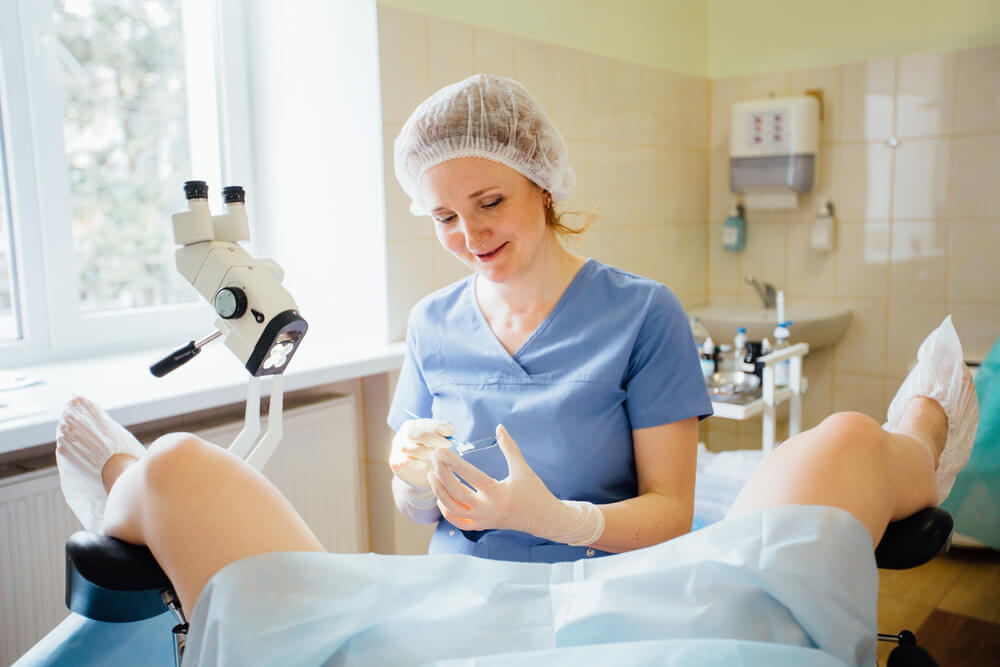Visiting your gynecologist regularly means that you undergo certain tests and procedures from time to time for preventive purposes. Although many women avoid going to their gynecologist until they have specific symptoms, it’s a good idea to do all the necessary examinations and tests once a year, Pap smear included.
If you’re new to this and still haven’t found out what does Pap mean, you’ve come to the right place! We’ll try to explain everything you need to know about Pap smears, their purpose, and use, so read on.
What Is a Pap Smear?
A Pap Smear test is a procedure done to diagnose cervical cancer in women of all ages. All women who regularly undergo a Pap smearing test have more chances to prevent and cure cervical cancer.
You might also be wondering about what does smearing mean and we’re here to explain it all. When a Pap smear test is done, the gynecologist collects a sample of cells from your cervix, the lower part of your vagina, for further examination. This is extremely helpful in early cervical cancer diagnosis, prevention, and cure.
Why Is a Pap Smear Done?
Just like we mentioned before, a Pap smear test is done to screen women of different ages and profiles for cervical cancer. It’s recommended that women start with Pap smear testing as early as 21 in order to prevent and diagnose unwanted changes in the cells of the cervix.
‘Does a Pap smear test for HIV?’ is a question many women ask, but the truth is that a Pap smear test can be combined with an HPV test that can detect the human papillomavirus if it’s present. Human papillomavirus is a very common, sexually-transmitted disease that is known to cause cervical cancer, so in some cases, this test is performed instead of a Pap smearing test.
Who Should Do a Pap Smear?
In consultation with your OB/GYN, you should decide when it’s best to start doing a Pap smear test. Most gynecologists recommend starting with Pap testing once a woman turns 21, but there is no universal formula. Every woman is different and should know and take care of her reproductive health well. 
How Often Should a Pap Smear Be Done?
Your gynecologist will determine how often you should do a Pap smear test, but generally, it’s recommended to do it every three years once you turn 21. Women who are thirty and older can consider having a Pap smear test every five years, but only if it’s combined with an HPV test.
If a Pap smear inflammation is present, or your doctor detects some risk factors, they might suggest doing a Pap smear test more often regardless of how old you are. Some of the factors include the following:
- An abnormal Pap smear test that shows precancerous cells or a cervical cancer diagnosis
- An HIV infection
- Exposure to DES before birth
- Being an active smoker
- Having a weakened immune system because of chemotherapy, organ transplants, or prolonged corticosteroid use
Make sure to inform your doctor about everything that might potentially be relevant for your Pap smear test. This can help them diagnose you properly and provide you with adequate care and treatment.
How To Prepare For a Pap Smear?
Preparing for a Pap smear testing is not complicated, but you can always consult your OB/GYN for more information. At Women’s Care of Bradenton, we always make sure our patients are familiar with all the procedures and tests, as well as to provide them with exceptional care and treatment. Our specialties include obstetrical and gynecological services, infertility treatments, and numerous procedures and tests. Contact us today and we will tell you everything you need to know!
To ensure your Pap smear results are good and valid, try to follow the necessary preparation before the test:
- Avoid sexual intercourse at least two days before the test
- Make sure not to use any vaginal medicines, douches, foams, creams, or gels two days before your Pap smear test since they can wash away any abnormal cells or obscure the test results
- Avoid scheduling a Pap smear test while you’re on your period
By following the tips above, you will increase the chances of getting a proper result and avoid doing the test again.
What Are the Risks of a Pap Smear?
Although the Papanicolaou test’s definition and name might sound scary, this test is actually a very low-risk and completely harmless way to detect any abnormalities and changes in a woman’s cervical cells. However, sometimes it’s possible to get false-negative results of a Pap smear test, due to a number of reasons.
A false-negative test means that the results show no abnormalities even though there are changes in the cervical cells. This can happen because:
- The cells were very inadequately collected
- There weren’t enough abnormal cells to collect for the test
- There was inflammation or blood that obscured the abnormal cell collection
It’s possible that abnormal cells stay undetected for some time, but since cervical cancer needs a few years to develop, you can work on prevention during that time and undergo another Pap smear test if necessary. A Pap smear test is the most effective in discovering abnormal cells and diagnosing cervical cancer. 
What to Expect During a Pap Smear?
A Pap smear examination is usually done in a gynecologist’s office and it lasts no longer than a few minutes. Your doctor will ask you to undress from the waist down and lie on the exam table with your legs in stirrups. After you’re comfortably settled, the gynecologist will insert a speculum into your vagina to hold its walls apart while they take a sample of the cells from your cervix. To do this, they will use a spatula and a soft brush.
A Pap smear test is not painful, but the speculum might cause a bit of uncomfortable feeling and pressure in your pelvic area. This will go away as soon as the doctor takes it out.
Asking your doctor can a Pap smear detect HIV is important if you suspect you might have it since you will be needing careful treatment, and probably more complex tests to get that result.
What Happens After a Pap Smear?
Once the doctor finishes with a Pap smearing test, you can return to your normal daily activities without any restrictions. Depending on the type of Pap smear test, they will put the samples on a glass slide or in a container with a special liquid. The samples are then taken to a laboratory for further examinations under a microscope to determine if there are signs of cancer or precancerous state.
Waiting for your Pap smearing meaning and results can take some time, so ask your gynecologists when to expect them and schedule another appointment.
Interpreting the Results of a Pap Smear
Once the results are ready, you will go to your doctor’s office for more details and information. To define your Pap’s results, they will either say the results are normal or abnormal:
- Normal Pap smear test results show that there were no abnormal cells discovered in the sample. When your results are normal, the doctor will say that your Pap smear test is negative and that’s the best possible outcome. After this, you won’t be needing any further treatment until you’re scheduled for another Pap smear test.
- If the doctor discovers abnormal cells in your Pap smear test, they will tell you that your results came back positive. This doesn’t have to mean you’re immediately diagnosed with cervical cancer, so try to remain calm. Depending on the type of cells and the overall result, your doctor will tell you what a positive Pap smear test means in your case. Some of the things your doctor might say to you include the following:
- Squamous Intraepithelial Lesion
This is used when the cells in your Pap smear test are in a precancerous state. If the changes in the cells are low-grade, it means that a few years can pass before this becomes cervical cancer. However, if they are high-grade, you might be diagnosed with cervical cancer sooner rather than later. In either case, your doctor will suggest further testing to ensure proper diagnosis and treatment. 
- Squamous Cell Cancer or Adenocarcinoma Cells
If this is the term used on your results, then the doctor is almost certain to diagnose you with cervical cancer. Cancer might be appearing in your glandular cells or the surface cells of your cervix or vagina. Your gynecologist will recommend prompt evaluation and treatment, and you should ask everything you want to know about it.
- Atypical Squamous Cells of Undetermined Significance (ASCUS)
With ASCUS, there are some abnormal cells discovered, but the changes in the cervix are not that serious or don’t show cancer and precancerous state. Your gynecologist can choose to do another test to discover the presence of certain viruses such as the HPV that are known to cause cervical cancer.
If no such viruses are detected after further testing, your results are not of great concern and you don’t have to worry. If, however, some high-risk viruses are discovered, you will be sent to more detailed tests to determine the gravity of your condition.
- Atypical Glandular Cells
If atypical glandular cells are detected in your result, you might need further testing as it’s not known whether they are cancerous or not. They usually grow in your cervix and uterus while producing mucus. They can be abnormal, but additional tests and screenings are necessary to make a proper diagnosis.
A Pap smear test is a common procedure performed to help prevent and diagnose cervical cancer. Together with other tests and procedures, it’s the most effective way of helping treat women who are diagnosed with cervical cancer or other precancerous conditions. Don’t avoid going to your gynecologist and be responsible about your reproductive health. Call us to schedule your appointment today. It can save your life!


